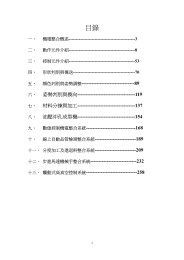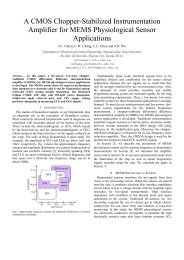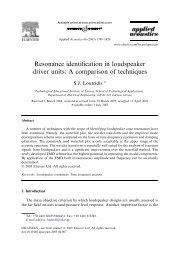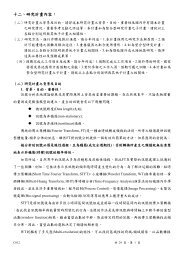IRIS RECOGNITION BASED ON HILBERT–HUANG TRANSFORM 1 ...
IRIS RECOGNITION BASED ON HILBERT–HUANG TRANSFORM 1 ...
IRIS RECOGNITION BASED ON HILBERT–HUANG TRANSFORM 1 ...
Create successful ePaper yourself
Turn your PDF publications into a flip-book with our unique Google optimized e-Paper software.
ROI {<br />
Iris Recognition Based on Hilbert–Huang Transform 629<br />
Fig. 3. The normalized iris image is vertically divided into four subregions. The three subregions<br />
1,2and3aretheROI.<br />
210<br />
200<br />
190<br />
180<br />
170<br />
160<br />
150<br />
140<br />
130<br />
120<br />
0 50 100 150 200 250 300 350 400 450 500<br />
x<br />
1<br />
2<br />
3<br />
4<br />
200<br />
150<br />
100<br />
0<br />
50<br />
0<br />
50 100 150 200 250 300 350 400 450 500<br />
−50<br />
0<br />
50<br />
50 100 150 200 250 300 350 400 450 500<br />
c1<br />
c2<br />
c3<br />
c4<br />
c5<br />
r<br />
0<br />
−50<br />
0<br />
50<br />
50 100 150 200 250 300 350 400 450 500<br />
0<br />
−50<br />
0<br />
50<br />
50 100 150 200 250 300 350 400 450 500<br />
0<br />
−50<br />
0 50 100 150 200 250 300 350 400 450 500<br />
20<br />
0<br />
−20<br />
0<br />
200<br />
50 100 150 200 250 300 350 400 450 500<br />
150<br />
0 50 100 150 200 250 300 350 400 450 500<br />
Fig. 4. Left, the 11th line signal of the normalized iris image in Fig. 3 along the horizontal<br />
direction. Right, the EMD decomposition result of the 11th line signal.<br />
An iris consists of some basic elements which are similar each other and interlaced<br />
each other. Hence, an iris image is generally periodic to some extent along<br />
some directions, that is, some approximate periods are embed in the iris image. As<br />
an example, let us observe the 11th line signal of the normalized iris image in Fig. 3<br />
along the horizontal direction, as show in the left of Fig. 4. It can be seen that most<br />
of the durations of the waves are similar, i.e. some main frequencies embed in the<br />
signal. As we know, the EMD can extract the low-frequency oscillations very well. 11<br />
With EMD, the decomposition result of the 11th line signal is shown in the right of<br />
Fig. 4. It can be seen that two main approximate periods are extracted in the third<br />
and fourth IMFs. To show it clearly, we plot the original signal (solid line) and the<br />
third IMF (dash line) together in the interval [320, 450] in the left of Fig. 5. It can<br />
be seen that this IMF characterizes the proximate period of the waveform quite well<br />
and the period is about 15 (i.e. the frequency is about 1/15 ≈ 0.067). Similarly, we<br />
plot the original signal (solid line) and the fourth IMF (dash line) together in the<br />
interval [320, 450] in the right of Fig. 5. It can be seen that this IMF characterizes<br />
the proximate period and the variety of the amplitude. This period is about 26 (i.e.<br />
the frequency is about 1/26 ≈ 0.0385).<br />
According to Eq. (3), we can compute the Hilbert marginal spectrum of the<br />
11th line signal of the normalized iris image in Fig. 3, as shown in the left of<br />
Fig. 6. It is evident that the two main frequencies can be extracted from the Hilbert<br />
marginal spectrum correctly. Based on lots of experiments and analysis we found

















